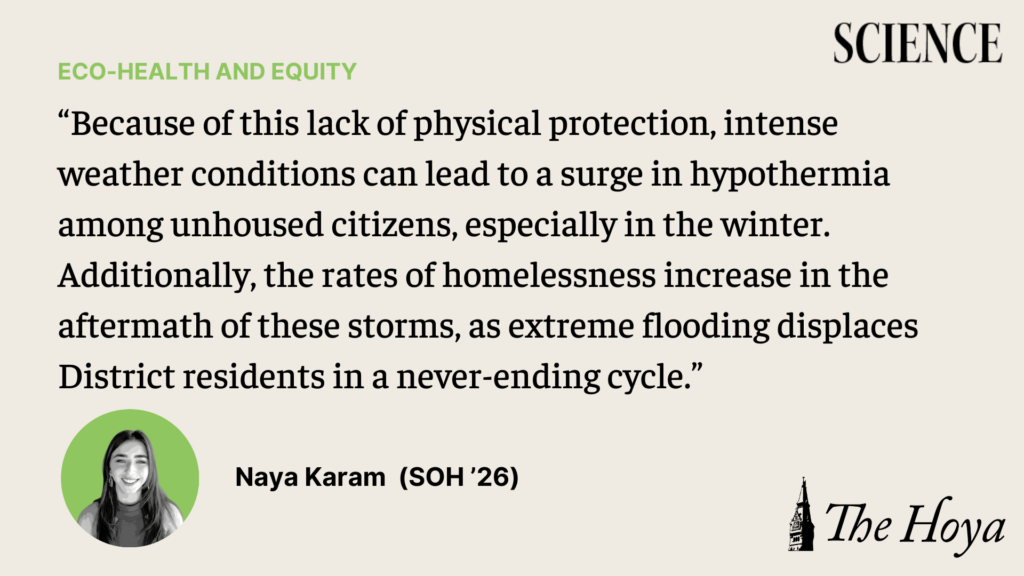By this point, people have recognized the harm that climate change is causing on our planet. Every corner of the Earth is being ravaged by the effects of this environmental catastrophe. The effects of climate change vary based on geography, but in the bustling city of Washington, D.C., climate change has led to intense rainfall, holding troubling implications for the District’s disadvantaged communities.
The unhoused population has higher exposure to rain and cold-induced illnesses, such as hypothermia, and those living in low-income communities face the immense burden of having to rebuild their homes time after time.
However, before examining the burdens to those groups, the link between rising temperatures and rising precipitation levels must be established. NASA explains that higher temperatures mean that more water from Earth’s oceans and lakes are likely to evaporate, causing more rain once they condense again.
NASA further states that although climate change can cause droughts in certain parts of the world, areas located in storm tracks, which are the zones through which storms travel, will bear the brunt of the rainfall brought on by the higher rates of evaporation. D.C. happens to be one of these “storm-affected” areas.
According to the Environmental Protection Agency, the District already suffers from flooding because of its nearby rivers, poor drainage systems and coastal surges. The high amounts of rainfall that D.C. is now experiencing are only exacerbating flooding of all types.
One of the groups significantly affected by all the rainfall and flooding is the unhoused population. Numerous unhoused individuals rely on old tents and tarps to protect against the rain, but these materials tend to be old and overused, leaving them with holes that let in the strong rain and winds.
Furthermore, concrete barriers have been put in places such as underpasses, leaving unhoused individuals with virtually nowhere to protect themselves.
Because of this lack of physical protection, intense weather conditions can lead to a surge in hypothermia among unhoused citizens, especially in the winter. Additionally, the rates of homelessness increase in the aftermath of these storms, as extreme flooding displaces District residents in a never-ending cycle.
The increase in severe flooding also disproportionately affects low-income areas of D.C., such as Watts Branch and Anacostia.
Lower-income communities are often forgotten when it comes to flood prevention protocols, infrastructure and resources. For example, residents living in the Lotus Square apartments, a building along the Anacostia River, reported to a local news station that they’ve been dealing with flooding and persistent mold in their homes for decades.
Street and building flooding also keeps people from work and schools, resulting in a decrease in wages and lower quality education. Moreover, the trauma of continuous disaster seriously impacts the mental health of these communities.
Regrettably, the situation seems to only be getting worse. The D.C. Department of Energy and Environment (DOEE) projects that by 2080, intense rainstorms that would currently occur once every century are predicted to happen once every fifteen years.
Still, there is hope.
Various individuals and organizations are taking action to minimize the harm of the rainstorms. The People for Fairness Coalition, for example, provides resources such as tents to unhoused individuals to aid in protecting against the elements.
The DOEE is also taking action by hosting fundraisers like community walks to increase community awareness of flood safety and fund more efficient infrastructure. The department is also working on expanding the sewage network by building larger tunnels to ensure that the District’s drainage systems no longer flood.
Though often suffering from limited resources and space, nonprofit organizations also play an important role in sheltering unhoused people during intense rainfall.
Nonetheless, D.C. needs to deal with the issue at the source. More funding should be diverted to flood-resistant infrastructure, especially housing for low-income individuals.
District residents can also help the city’s disadvantaged populations by donating to, and volunteering for, organizations that assist unhoused individuals in the area, such as the D.C. Coalition for the Homeless. Support from the community will be one of the strongest tools available to combat the effects of climate change.









